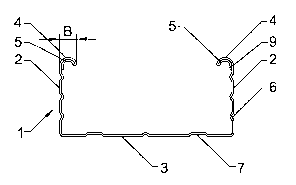Une partie des informations de ce site Web a été fournie par des sources externes. Le gouvernement du Canada n'assume aucune responsabilité concernant la précision, l'actualité ou la fiabilité des informations fournies par les sources externes. Les utilisateurs qui désirent employer cette information devraient consulter directement la source des informations. Le contenu fourni par les sources externes n'est pas assujetti aux exigences sur les langues officielles, la protection des renseignements personnels et l'accessibilité.
L'apparition de différences dans le texte et l'image des Revendications et de l'Abrégé dépend du moment auquel le document est publié. Les textes des Revendications et de l'Abrégé sont affichés :
| (12) Demande de brevet: | (11) CA 2653635 |
|---|---|
| (54) Titre français: | PROFILE EN TOLE POUR LA CONSTRUCTION SECHE |
| (54) Titre anglais: | SHEET METAL SECTION FOR DRY CONSTRUCTION |
| Statut: | Réputée abandonnée et au-delà du délai pour le rétablissement - en attente de la réponse à l’avis de communication rejetée |
| (51) Classification internationale des brevets (CIB): |
|
|---|---|
| (72) Inventeurs : |
|
| (73) Titulaires : |
|
| (71) Demandeurs : |
|
| (74) Agent: | BORDEN LADNER GERVAIS LLP |
| (74) Co-agent: | |
| (45) Délivré: | |
| (86) Date de dépôt PCT: | 2006-11-07 |
| (87) Mise à la disponibilité du public: | 2007-12-06 |
| Licence disponible: | S.O. |
| Cédé au domaine public: | S.O. |
| (25) Langue des documents déposés: | Anglais |
| Traité de coopération en matière de brevets (PCT): | Oui |
|---|---|
| (86) Numéro de la demande PCT: | PCT/EP2006/010636 |
| (87) Numéro de publication internationale PCT: | WO 2007137618 |
| (85) Entrée nationale: | 2008-11-27 |
| (30) Données de priorité de la demande: | ||||||
|---|---|---|---|---|---|---|
|
L'invention concerne un profilé (1) en tôle pour la construction sèche comprenant deux sections ailes (2) et une section fond (3) reliant les sections ailes (2), un bord porteur (4) replié s'étendant dans la direction longitudinale du profilé (1) étant prévu dans au moins une section aile (2), une bande de renforcement (5) étant prévue sur le bord porteur (4) replié. Le profilé est caractérisé en ce que la bande de renforcement (5) s'étend sur toute la largeur (B) du bord porteur (4) replié.
The invention relates to a sheet metal section (1) for dry construction, comprising two limb portions (2) and a base portion (3) that connects said limb portions (2). According to the invention, at least one of the limb portions (2) is equipped with a bent supporting edge (4) that extends in the longitudinal direction of the section (1), said bent supporting edge (4) being provided with a reinforcement strip (5). The section is characterised in that the reinforcement strip (5) extends over the entire width (B) of the bent supporting edge (4).
Note : Les revendications sont présentées dans la langue officielle dans laquelle elles ont été soumises.
Note : Les descriptions sont présentées dans la langue officielle dans laquelle elles ont été soumises.

2024-08-01 : Dans le cadre de la transition vers les Brevets de nouvelle génération (BNG), la base de données sur les brevets canadiens (BDBC) contient désormais un Historique d'événement plus détaillé, qui reproduit le Journal des événements de notre nouvelle solution interne.
Veuillez noter que les événements débutant par « Inactive : » se réfèrent à des événements qui ne sont plus utilisés dans notre nouvelle solution interne.
Pour une meilleure compréhension de l'état de la demande ou brevet qui figure sur cette page, la rubrique Mise en garde , et les descriptions de Brevet , Historique d'événement , Taxes périodiques et Historique des paiements devraient être consultées.
| Description | Date |
|---|---|
| Demande non rétablie avant l'échéance | 2012-11-07 |
| Le délai pour l'annulation est expiré | 2012-11-07 |
| Inactive : Abandon.-RE+surtaxe impayées-Corr envoyée | 2011-11-07 |
| Réputée abandonnée - omission de répondre à un avis sur les taxes pour le maintien en état | 2011-11-07 |
| Lettre envoyée | 2009-03-25 |
| Inactive : Page couverture publiée | 2009-03-20 |
| Inactive : Notice - Entrée phase nat. - Pas de RE | 2009-03-18 |
| Inactive : CIB en 1re position | 2009-03-11 |
| Demande reçue - PCT | 2009-03-10 |
| Inactive : Transfert individuel | 2008-12-15 |
| Exigences pour l'entrée dans la phase nationale - jugée conforme | 2008-11-27 |
| Demande publiée (accessible au public) | 2007-12-06 |
| Date d'abandonnement | Raison | Date de rétablissement |
|---|---|---|
| 2011-11-07 |
Le dernier paiement a été reçu le 2010-10-26
Avis : Si le paiement en totalité n'a pas été reçu au plus tard à la date indiquée, une taxe supplémentaire peut être imposée, soit une des taxes suivantes :
Veuillez vous référer à la page web des taxes sur les brevets de l'OPIC pour voir tous les montants actuels des taxes.
| Type de taxes | Anniversaire | Échéance | Date payée |
|---|---|---|---|
| Taxe nationale de base - générale | 2008-11-27 | ||
| TM (demande, 2e anniv.) - générale | 02 | 2008-11-07 | 2008-11-27 |
| Enregistrement d'un document | 2008-12-15 | ||
| TM (demande, 3e anniv.) - générale | 03 | 2009-11-09 | 2009-10-27 |
| TM (demande, 4e anniv.) - générale | 04 | 2010-11-08 | 2010-10-26 |
Les titulaires actuels et antérieures au dossier sont affichés en ordre alphabétique.
| Titulaires actuels au dossier |
|---|
| RICHTER SYSTEM GMBH & CO. KG |
| Titulaires antérieures au dossier |
|---|
| ALFONS JEAN KNAUF |